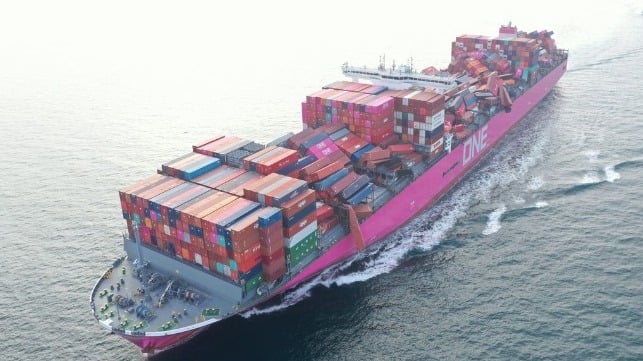Video: Drone Survey of ONE Apus Container Collapse

The cargo claims consultancy WK Webster released the first images of its initial damage survey of the container ship ONE Apus. The company’s inspectors were in Kobe, Japan for the arrival of the vessel and they also conducted a remote drone survey as it transited Osaka Bay towards Kobe Port.
The images are being used by Webster and its clients to understand the scope of the incident while excerpts have been posted on the company’s website for the public to view. The images were taken by two drones using ultra-high definition camera technology as part of the company’s new drone survey product. The images very clearly show the scale and detail of the devastation on board and are being analyzed in conjunction with experts appointed by Webster.
The process of removing containers from the ONE Apus began on December 11 after permission was granted by the Japanese Coast Guard. The ship’s owners, Chidori Ship Holding, and managers, NYK Shipmanagement, which had operated the vessel as part of the ONE Express Network estimated that it would take “over a month” to remove the dislodged containers using a schedule formulated by stowage planners. “Once unloaded, each will be assessed, and when the discharge of cargo is complete, there will be a full assessment of damage to the vessel and subsequent repairs,” they said in a prepared statement.
Webster’s team of surveyors in Japan, however, reports that the process started slowly. Only five containers were removed from the vessel last week and work did not proceed over the weekend. Webster also termed the owner’s assessment of the timeline for the process as “optimistic.”
From its team’s initial visual assessment and the analysis of the video and still images, Webster reports that it can be seen that there are 22 bays on deck of which 16 have collapsed to both port and starboard, leaving only six intact or partially intact. “With 20 rows of containers per bay and with stack heights of between six and eight containers, we anticipate that approximately 2,250 containers have been lost or damaged,” they reported. They also noted that the vast majority appear to be 40 foot units and therefore equivalent to approximately 4,500 TEU.
“The vessel owners/operators are not currently prepared to release the vessel's stowage/bay plans,” they said in their update making it more challenging for customers to determine the status of their shipments. Webster said it was seeking further information regarding the fate of individual containers on a case-by-case basis, but noted that “It is likely that some of the upper stowed containers were either empty or holding lighter weight goods.”
While the images clearly show the extent of the toppled stacks, thousands of containers remain on deck and will have to be examined individually to determine the full extent of any internal damage. The vessel had a capacity of 14,000 TEUs with the managers saying that a total of 1,816 containers were lost over the side when the vessel encountered heavy weather on November 30 in the Pacific at a position about 1,600 nautical miles northwest of Hawaii.
Webster and its experts are continuing to analyze the evidence with the company preliminarily saying the total loss could exceed $200 million, and it could be greater than the value of the vessel which was built in 2019.
Among the issues Webster will be considering in determining the cause of the incident are the weather conditions encountered and what was done by the vessel to mitigate the impact of the weather. They will also be looking at the lashing and securing equipment used and its adequacy, the stowage condition of the vessel on departure from Yantian, China, and the voyage planning, as well as other issues.

that matters most
Get the latest maritime news delivered to your inbox daily.
The owners and managers of the ONE Apus have also said that a thorough investigation is being conducted into the incident and, of course, Japan as the vessel’s flag state, and other maritime authorities are also investigating. Due to the size and complexity of the loss, it will likely take some time before a report will be available and what steps will be taken to reduce future risks.
The video and images can be viewed on Webster’s website.
